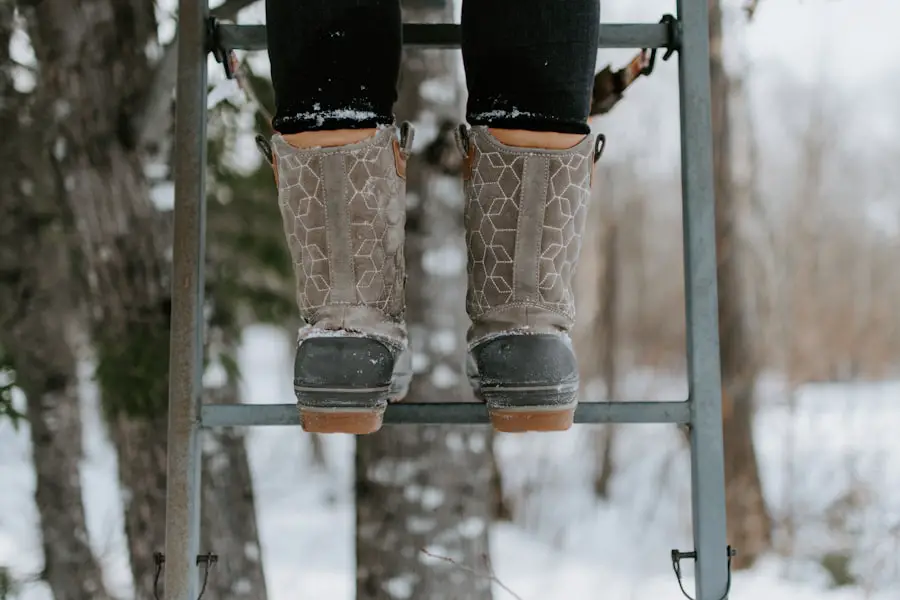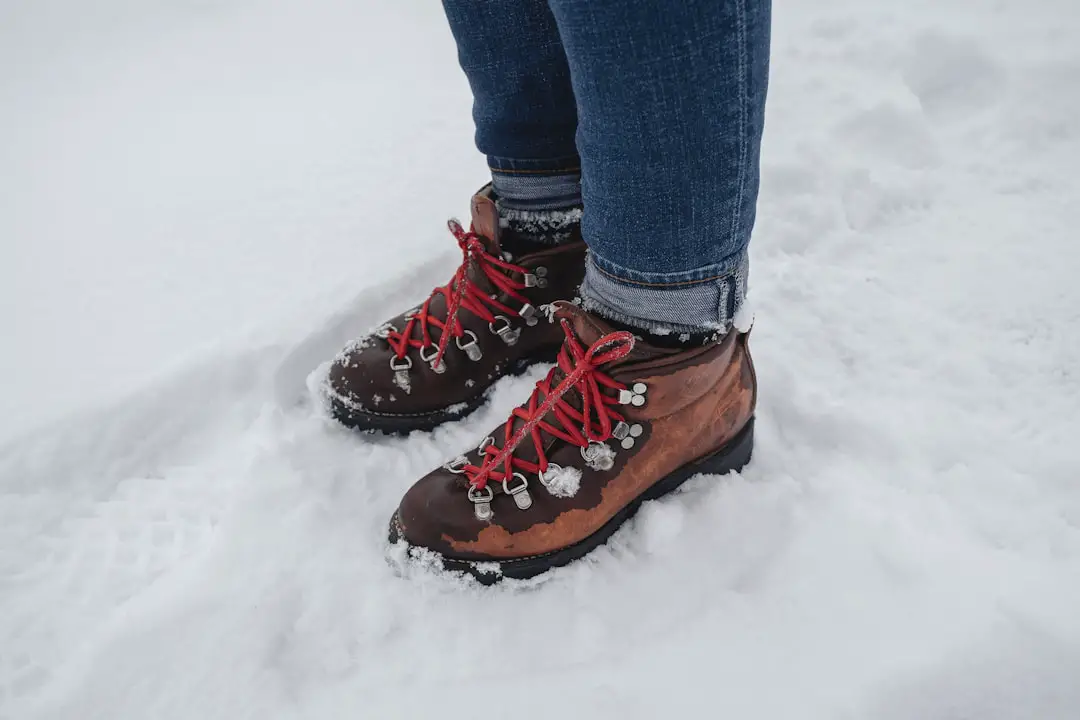When venturing into the great outdoors, the choice of footwear can significantly impact your experience, especially when comparing hiking boots and snow boots. Hiking boots are designed primarily for rugged terrain, providing support and stability on uneven surfaces. They typically feature a stiffer sole to handle rocky paths and are often made from breathable materials to keep feet comfortable during long treks.
The design of hiking boots emphasizes ankle support, which is crucial for preventing injuries on trails that may include roots, rocks, and other obstacles. In contrast, snow boots are specifically engineered for cold, wet, and slippery conditions. Their construction prioritizes insulation and waterproofing to keep feet warm and dry in snow and slush.
Snow boots often have a looser fit around the ankle to accommodate thicker socks and allow for easier movement in deep snow. The soles of snow boots are designed with deep treads to provide traction on icy surfaces, which is a critical feature that distinguishes them from hiking boots. While both types of footwear serve distinct purposes, understanding their differences is essential for selecting the right pair for your outdoor activities.
Key Takeaways
- Hiking boots are designed for hiking on various terrains, while snow boots are specifically designed for walking in snowy and icy conditions.
- Insulation is crucial in snow boots to keep feet warm and protected from the cold, while hiking boots may not have the same level of insulation.
- Traction is a key factor in snow boots to prevent slipping on icy surfaces, whereas hiking boots may have less aggressive treads.
- Waterproofing is a must-have feature in snow boots to keep feet dry in snowy conditions, while hiking boots may offer some level of water resistance.
- Snow boots provide more warmth, support, and protection in cold weather compared to hiking boots.
The Importance of Insulation in Snow Boots
Insulation is a defining characteristic of snow boots, as it plays a crucial role in maintaining warmth in frigid temperatures. Most snow boots utilize materials such as Thinsulate or fleece linings that trap heat while allowing moisture to escape. This balance is vital because, in cold weather, the risk of frostbite increases significantly if feet become wet and cold.
Insulated snow boots can maintain warmth even in sub-zero temperatures, making them indispensable for winter activities like snowshoeing or walking through deep snow. In contrast, hiking boots generally lack the level of insulation found in snow boots. While some hiking boots may offer moderate insulation for cooler weather, they are not designed to withstand extreme cold.
The primary focus of hiking boots is breathability and moisture management, which can lead to a compromise in warmth during winter excursions.
Therefore, if you plan to engage in activities where exposure to snow and cold is inevitable, investing in a quality pair of insulated snow boots is essential for comfort and safety.Traction: A Key Factor in Snow Boots

Traction is another critical aspect that sets snow boots apart from hiking boots. The outsoles of snow boots are typically made from rubber compounds that remain flexible in low temperatures, providing superior grip on icy surfaces. The tread patterns on snow boots are designed with deep lugs that enhance traction, allowing for better stability when walking on slippery terrain.
This feature is particularly important when navigating through packed snow or icy patches, where slipping can lead to falls and injuries. Hiking boots, while they do offer some level of traction, are not optimized for winter conditions. Their tread patterns are often shallower and designed for grip on rocky or uneven surfaces rather than ice or snow.
As a result, wearing hiking boots in snowy conditions can be risky, as they may not provide the necessary grip to prevent slips and falls. For those who frequently find themselves in winter environments, choosing snow boots with excellent traction is paramount for ensuring safety and confidence while traversing snowy landscapes.
Waterproofing: A Must-Have Feature in Snow Boots
| Brand | Boot Model | Waterproofing Technology | Price Range |
|---|---|---|---|
| Columbia | Men’s Bugaboot Plus IV Omni-Heat | Omni-Tech | 150 – 200 |
| The North Face | Women’s Chilkat 400 | HydroSeal | 120 – 160 |
| Merrell | Men’s Moab 2 Mid Waterproof | M Select DRY | 120 – 150 |
Waterproofing is an essential feature of snow boots that cannot be overlooked. Snow and slush can quickly soak through footwear that lacks adequate waterproofing, leading to cold and uncomfortable feet. Most quality snow boots incorporate waterproof membranes such as Gore-Tex or proprietary waterproof technologies that keep moisture out while allowing sweat to escape.
This dual functionality ensures that feet remain dry during prolonged exposure to wet conditions. In contrast, many hiking boots are designed with breathability in mind rather than complete waterproofing. While some hiking boots do offer waterproof options, they may not be as effective in keeping out water as dedicated snow boots.
The materials used in hiking boots often prioritize ventilation to prevent overheating during strenuous activities, which can compromise their ability to repel water effectively. Therefore, if you anticipate walking through deep snow or slushy conditions, selecting snow boots with robust waterproofing features is crucial for maintaining comfort and warmth.
Comfort and Support: How Hiking Boots Compare to Snow Boots
Comfort and support are paramount when choosing footwear for outdoor activities, but the requirements differ between hiking and snow boots. Hiking boots are designed to provide excellent arch support and cushioning for long-distance walking on trails. They often feature padded collars and tongues that enhance comfort around the ankle while minimizing the risk of blisters during extended hikes.
The stiffer soles of hiking boots also contribute to stability on uneven terrain, allowing hikers to navigate challenging paths with confidence. Snow boots prioritize warmth and ease of wear over the specific support features found in hiking boots. While they do offer some cushioning, the focus is more on insulation and waterproofing than on providing extensive arch support or stability for long hikes.
Many snow boots have a more relaxed fit to accommodate thicker socks and allow for easier movement in deep snow. This design can sometimes lead to less support compared to hiking boots, which may be a consideration for those who plan to engage in strenuous activities while wearing them.
Temperature Ratings: Why Snow Boots are Essential in Cold Weather

Temperature ratings are a critical factor when selecting snow boots, as they indicate the lowest temperature at which the boot can keep your feet warm. Many manufacturers provide temperature ratings based on laboratory testing, which helps consumers choose the right boot for their specific climate conditions. For instance, some snow boots are rated for temperatures as low as -40°F (-40°C), making them suitable for extreme winter conditions where frostbite can occur within minutes.
Hiking boots typically do not come with temperature ratings because they are not designed for extreme cold weather use. Instead, they focus on breathability and moisture management for warmer climates or milder winter conditions. This lack of temperature rating means that hikers venturing into snowy environments may find themselves inadequately protected against the cold if they rely solely on their hiking footwear.
Therefore, understanding temperature ratings is essential for anyone planning outdoor activities in winter weather.
The Role of Height in Snow Boots
The height of snow boots plays a significant role in their functionality during winter activities. Snow boots come in various heights—ankle-high, mid-calf, and knee-high—each serving different purposes based on the depth of snow and the level of protection required. Ankle-high snow boots may be suitable for light snowfall or urban environments where deep snow is not a concern.
However, mid-calf or knee-high options provide added protection against deeper snowdrifts and prevent snow from entering the boot. In contrast, hiking boots typically have a lower profile that offers less coverage against snow accumulation. While some hiking boots may extend slightly above the ankle for added support, they do not provide the same level of protection against deep snow as taller snow boots do.
For individuals who frequently hike in snowy conditions or engage in activities like snowshoeing or backcountry skiing, opting for taller snow boots can significantly enhance comfort and performance by keeping feet dry and warm.
The Impact of Weight on Hiking Boots vs Snow Boots
Weight is an important consideration when comparing hiking boots to snow boots, as it can affect overall performance during outdoor activities. Hiking boots are generally designed to be lightweight to facilitate agility and speed on trails. This lightweight construction allows hikers to cover more ground without feeling weighed down by their footwear.
Many modern hiking boot designs utilize advanced materials that provide durability without adding unnecessary bulk. On the other hand, snow boots tend to be heavier due to their insulation and waterproofing features. The materials used in their construction often include thicker rubber outsoles and additional layers of insulation that contribute to their overall weight.
While this added weight can provide benefits such as increased warmth and protection against harsh winter conditions, it may also lead to fatigue during extended wear. For those who prioritize speed and agility in their outdoor pursuits, lightweight hiking boots may be more suitable than heavier snow boots.
Flexibility: Can Hiking Boots Match the Flexibility of Snow Boots?
Flexibility is another area where hiking boots and snow boots differ significantly. Hiking boots are designed with stiffer soles that provide stability on uneven terrain but may sacrifice some flexibility in the process. This rigidity is beneficial when navigating rocky trails but can limit movement when walking through soft or deep snow where more flexibility is advantageous.
Snow boots typically offer greater flexibility due to their softer construction materials and design aimed at accommodating movement in snowy conditions. This flexibility allows for easier walking through deep snow or maneuvering over obstacles like fallen branches or ice patches without feeling restricted by stiff soles. For individuals who engage in activities that require a lot of movement in snowy environments—such as building a snowman or playing in the snow—snow boots provide the necessary flexibility that hiking boots may lack.
Durability: Evaluating the Longevity of Hiking Boots in Snowy Conditions
Durability is a crucial factor when evaluating footwear for outdoor activities, particularly when considering how well hiking boots perform in snowy conditions compared to dedicated snow boots. Hiking boots are constructed from robust materials designed to withstand rough terrain and abrasive surfaces encountered on trails. High-quality leather or synthetic uppers combined with reinforced stitching contribute to their longevity under normal hiking conditions.
However, when exposed to harsh winter elements such as salt from roads or prolonged moisture from wet snow, hiking boots may experience accelerated wear and tear compared to their snow boot counterparts. Snow boots are specifically designed to endure cold temperatures and wet conditions without compromising their structural integrity over time. Their materials are often treated to resist salt damage and prevent water penetration effectively, ensuring they remain functional throughout multiple winter seasons.
Determining if Hiking Boots Can Double as Snow Boots
While it may be tempting to use hiking boots as a substitute for snow boots during winter excursions, it’s essential to recognize their limitations in snowy conditions. Hiking boots excel in providing support and stability on rugged trails but fall short when it comes to insulation, waterproofing, traction, and overall warmth required for snowy environments. Snow boots are purpose-built for cold weather challenges, offering features specifically designed to keep feet warm and dry while providing adequate grip on slippery surfaces.
Ultimately, choosing the right footwear depends on your intended activities and environmental conditions. If you plan on engaging primarily in winter sports or spending extended periods outdoors in snowy conditions, investing in a quality pair of insulated snow boots will enhance your comfort and safety significantly compared to relying solely on hiking footwear. Understanding these differences will help ensure you make informed decisions about your outdoor gear choices.
If you’re planning on hiking in snowy conditions, you may be wondering if hiking boots can double as snow boots. According to a related article on TakeTravelInfo, having the right gear is essential for outdoor activities in winter. They recommend investing in a good pair of snow boots specifically designed for cold and wet conditions to ensure your feet stay warm and dry. Check out their article on the best power bank for international travel for more tips on staying prepared for your winter adventures. Click here to read more.
FAQs
Can hiking boots be used as snow boots?
Yes, hiking boots can be used as snow boots in certain conditions. However, they may not provide the same level of warmth and waterproofing as traditional snow boots.
What are the differences between hiking boots and snow boots?
Hiking boots are designed for hiking on various terrains and may not provide the same level of insulation and waterproofing as snow boots. Snow boots are specifically designed to keep feet warm and dry in snowy and wet conditions.
What should I consider when using hiking boots as snow boots?
When using hiking boots as snow boots, consider the temperature and moisture levels of the snow. If the snow is wet and slushy, hiking boots may not provide adequate protection. Additionally, consider adding extra insulation or waterproofing to the hiking boots if using them in snowy conditions.
Can hiking boots provide enough traction in snowy conditions?
Hiking boots may provide sufficient traction in light snow, but they may not have the same level of grip as snow boots with specialized treads for icy and slippery conditions.
Are there any specific features to look for in hiking boots if using them as snow boots?
If using hiking boots as snow boots, look for models with insulation, waterproofing, and a higher ankle height for added protection from the snow. Additionally, consider adding traction devices or snowshoes for improved grip in snowy conditions.
